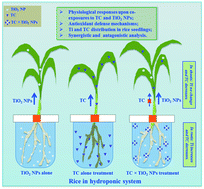当前位置:
X-MOL 学术
›
Environ. Sci.: Nano
›
论文详情
Our official English website, www.x-mol.net, welcomes your feedback! (Note: you will need to create a separate account there.)
Effects of titanium oxide nanoparticles on tetracycline accumulation and toxicity in Oryza sativa (L.)
Environmental Science: Nano ( IF 7.3 ) Pub Date : 2017-07-18 00:00:00 , DOI: 10.1039/c7en00280g Chuanxin Ma,Hong Liu,Guangcai Chen,Qing Zhao,Brian Eitzer,Zonghua Wang,Wenjun Cai,Lee A. Newman,Jason C. White,Om Parkash Dhankher,Baoshan Xing
Environmental Science: Nano ( IF 7.3 ) Pub Date : 2017-07-18 00:00:00 , DOI: 10.1039/c7en00280g Chuanxin Ma,Hong Liu,Guangcai Chen,Qing Zhao,Brian Eitzer,Zonghua Wang,Wenjun Cai,Lee A. Newman,Jason C. White,Om Parkash Dhankher,Baoshan Xing

|
Although both antibiotic residues and metal-based nanoparticles (NPs) are common emerging pollutants, little is known about their potential co-contaminant interactions, including resulting impacts on sensitive biota such as food crops. This study assessed the impact of tetracycline (TC, 5–20 mg L−1) and titanium dioxide (TiO2, 500–2000 mg L−1) NPs co-exposure on rice (Oryza sativa L.) under a 10 d hydroponic exposure. Plant biomass, contaminant content (TC, Ti), oxidative stress enzymes, and macro-/micronutrient contents were measured in rice shoots and roots as a function of exposure. Under TC alone exposure, dose-dependent toxicity (biomass, oxidative stress enzymes) and TC accumulation were observed and the levels of several key elemental nutrients were decreased. For example, root biomass treated with 5 and 20 mg L−1 TC was reduced by 18.8% and 62.5%, respectively, relative to the control. The contents of K, P, and S in 10 and 20 mg L−1 TC treated rice shoots were approximately 80% of the unamended control. Under co-exposure, the presence of TiO2 NPs significantly enhanced the TC treated rice growth in terms of plant size and total biomass. In addition, TiO2 NPs significantly reduced the levels of TC in rice shoots and roots, as well as oxidative stress enzymes, back to the level of unamended controls and also enabled recovery of TC-induced nutrient deficiency. It is worth mentioning that both contaminants resulted in severe iron deficiency (44–76% decreases of Fe in all the treatments were evident) under both single and co-exposure treatments. Abiotic sorption data indicates that TC phytotoxicity was prevented due to sorption of the antibiotic onto NP TiO2 (a maximum amount was 2.62 mg g−1), resulting in significantly decreased availability to the rice seedlings. The presence of TC increased the Ti content in rice roots, which could be ascribed to the alteration of surface charges of TiO2 NPs as affected by TC. Antagonistic and synergistic effects of TiO2 NPs and TC on rice were analyzed using three methods, including toxicity unit (TU), additional index (AI), and mixture toxicity index (MTI), all of which indicated under co-exposing condition, TiO2 NPs and TC interacted antagonistically, resulting in an overall alleviation of phytotoxicity and enhanced plant health.
中文翻译:

四环素积累和毒性在氧化钛纳米粒子的效果水稻(L.)
尽管抗生素残留物和金属基纳米颗粒(NPs)都是常见的新兴污染物,但对其潜在的共污染物相互作用(包括对敏感生物群(如粮食作物)的影响)知之甚少。本研究评估四环素(TC,5-20毫克的L的影响-1)(二氧化钛和二氧化钛2,500-2000毫克的L -1)上的NP大米共曝光(稻L.)在10 d水耕下暴露。测定稻苗和根中植物生物量,污染物含量(TC,Ti),氧化应激酶和宏观/微量营养素含量,作为暴露量的函数。在单独的TC暴露下,观察到剂量依赖性毒性(生物量,氧化应激酶)和TC积累,并且几种关键元素营养素的水平降低。例如,相对于对照,用5和20mg L -1 TC处理的根生物量分别减少了18.8%和62.5%。10和20 mg L -1 TC处理的水稻芽中K,P和S的含量约为未修正对照的80%。在共同暴露下,TiO 2的存在在植物大小和总生物量方面,NPs显着增强了经过TC处理的水稻的生长。此外,TiO 2 NPs显着降低了水稻新梢和根中的TC含量以及氧化应激酶,使其恢复到未修改的对照水平,并且还可以恢复TC诱导的营养缺乏。值得一提的是,在一次和联合暴露处理下,两种污染物均导致严重的铁缺乏(在所有处理中,Fe含量均降低了44%至76%)。非生物吸附数据表明,由于将抗生素吸附到NP TiO 2上,可防止TC的植物毒性(最大量为2.62 mg g -1),导致水稻幼苗的可利用性大大降低。TC的存在增加了水稻根部的Ti含量,这可能是由于TC影响了TiO 2 NPs表面电荷的变化。TiO 2 NPs和TC对水稻的拮抗和协同作用采用毒性单位(TU),附加指数(AI)和混合物毒性指数(MTI)三种方法进行了分析,所有这些方法均在共暴露条件下TiO指示。2个NP和TC拮抗相互作用,从而总体上减轻了植物毒性并增强了植物健康。
更新日期:2017-09-14
中文翻译:

四环素积累和毒性在氧化钛纳米粒子的效果水稻(L.)
尽管抗生素残留物和金属基纳米颗粒(NPs)都是常见的新兴污染物,但对其潜在的共污染物相互作用(包括对敏感生物群(如粮食作物)的影响)知之甚少。本研究评估四环素(TC,5-20毫克的L的影响-1)(二氧化钛和二氧化钛2,500-2000毫克的L -1)上的NP大米共曝光(稻L.)在10 d水耕下暴露。测定稻苗和根中植物生物量,污染物含量(TC,Ti),氧化应激酶和宏观/微量营养素含量,作为暴露量的函数。在单独的TC暴露下,观察到剂量依赖性毒性(生物量,氧化应激酶)和TC积累,并且几种关键元素营养素的水平降低。例如,相对于对照,用5和20mg L -1 TC处理的根生物量分别减少了18.8%和62.5%。10和20 mg L -1 TC处理的水稻芽中K,P和S的含量约为未修正对照的80%。在共同暴露下,TiO 2的存在在植物大小和总生物量方面,NPs显着增强了经过TC处理的水稻的生长。此外,TiO 2 NPs显着降低了水稻新梢和根中的TC含量以及氧化应激酶,使其恢复到未修改的对照水平,并且还可以恢复TC诱导的营养缺乏。值得一提的是,在一次和联合暴露处理下,两种污染物均导致严重的铁缺乏(在所有处理中,Fe含量均降低了44%至76%)。非生物吸附数据表明,由于将抗生素吸附到NP TiO 2上,可防止TC的植物毒性(最大量为2.62 mg g -1),导致水稻幼苗的可利用性大大降低。TC的存在增加了水稻根部的Ti含量,这可能是由于TC影响了TiO 2 NPs表面电荷的变化。TiO 2 NPs和TC对水稻的拮抗和协同作用采用毒性单位(TU),附加指数(AI)和混合物毒性指数(MTI)三种方法进行了分析,所有这些方法均在共暴露条件下TiO指示。2个NP和TC拮抗相互作用,从而总体上减轻了植物毒性并增强了植物健康。


























 京公网安备 11010802027423号
京公网安备 11010802027423号